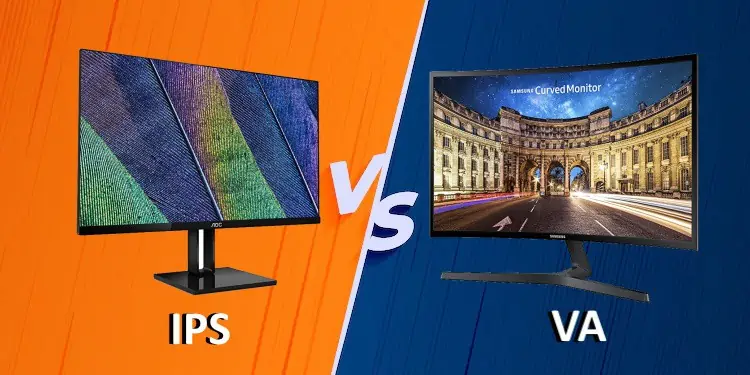In Plane Switching (IPS) and Vertical Alignment (VA) are the two best middle-ground LCD display technologies available today. So, if you’re looking to buy a new monitor or a TV, you might be wondering whether to get an IPS or a VA panel for your display.
When it comes to their display, users generally focus on parameters such as color reproduction, contrast ratio, viewing angles, refresh rates, response time, ghosting, etc depending upon their use case. You might prefer a stronger performance in one area while you might not care much for another. The type of your workload and budget might come into consideration.
So what is your use case, and which panel best suits your needs? We will dive into details about all these things in the article below.
What is an LCD Display Technology
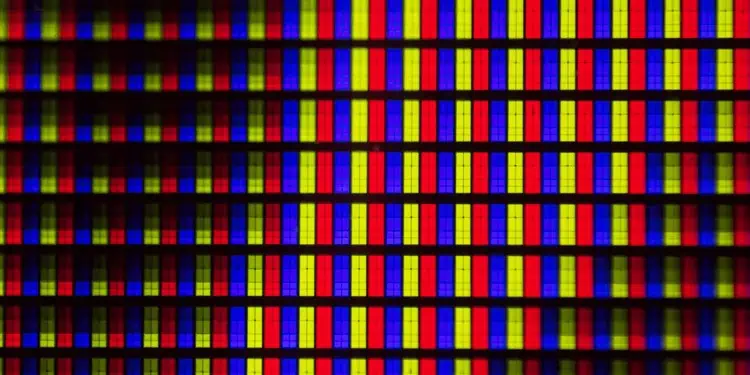
A Liquid Crystal Display (LCD) is a flat panel display that uses light modulation via liquid crystals, in conjunction with polarizers and a backlight to display an image on the screen.
The backlight produces light, which gets polarized by the filters. Liquid crystals in certain orientation allow the polarized lights to pass through them while in a different orientation, the passage of light is blocked.
The Liquid Crystal layer determines the intensity and the color of the light that is let through to produce the desired image.
A matrix of liquid crystals, polarizers, and backlights can be arranged to produce tiny dots on a screen, which are effectively pixels.
There are different types of LCD display technologies available, viz., Twisted Nematic (TN), In Plane Switching (IPS), and Vertical Alignment (VA). Their variation comes from the initial arrangement of liquid crystals and their behavior when a voltage is applied.
What is an IPS Panel?
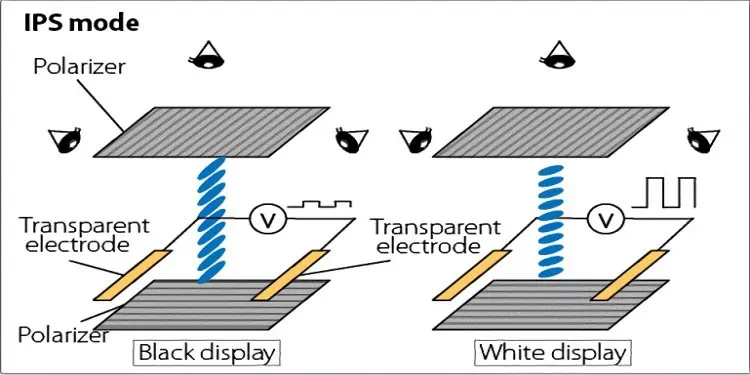
An IPS panel has liquid crystals sandwiched between two glass surfaces. The crystals are arranged in a plane parallel to the display (in-plane). Applying an electric field to the crystals rotates them in-plane, allowing for passage of polarized light, which creates a display on the display surface (screen).
Talking about panel performance, IPS panels do well in Adobe RGB and Rec.2020 color spaces. However, their lower performance in contrast ratio can be undesirable when dealing with contrast heavy works. They are able to attain sufficient brightness to perform under daylight.
Among every available display technologies today, IPS panels currently have the highest refresh rate. However, IPS panels generally are affected by IPS bleed, which is an undesirable quality in a display panel.
- Good color reproduction
- Excellent viewing angles.
- Good visibility under sunlight.
- Better refresh rate.
- Not great contrast ratio when compared to VA panels.
- Are susceptible to IPS bleed.
What is a VA Panel
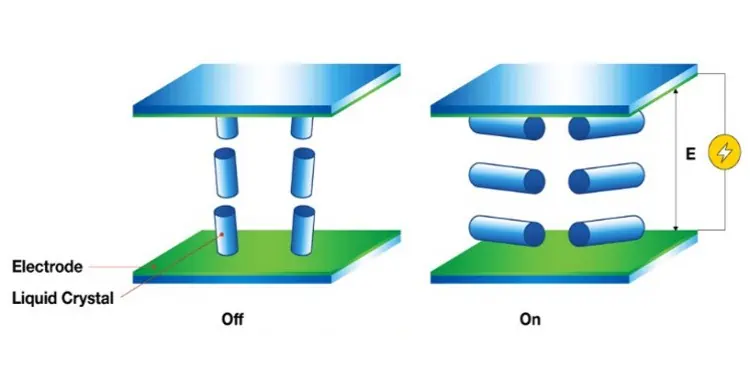
A VA panel has its liquid crystals suspended in a vertical orientation to the plane of display (glass substrate). These are arranged to not allow polarized light to pass through when no electric field is present. But when a voltage is applied, the crystals shift to a tilted position, allowing light to pass through, which can then hit the screen and produce a display.
VA panels have a decent coverage of sRGB and DCI-P3 color gamuts, which is suitable for video playback and playing video games. In addition, most VA panels available in the market today are curved screens, which can help with the experience of immersion. VA panels are also able to achieve the highest contrast ratio for an LCD panel, which is a desirable feature for enjoying HDR contents.
Backlight bleed in VA panels is more manageable, and they also can perform decently under daylight.
- Good contrast ratio.
- Better back light bleed management.
- Decent performance under sunlight.
- Worse color reproduction than an IPS panel
- Worse refresh rate than an IPS panel.
- Curved VA panels have reduced viewing angle.
Comparing IPS and VA Panels
Regardless of the similarities or differences in the technology implemented to produce the desired result in IPS and VA panels, as end users, we generally tend to focus on the performance of these panels instead.
The metrics that we can use to tangibly judge the strength and weakness of a particular type of panel, when it comes to display technology, are:
- Contrast ratio.
- Color reproduction.
- Brightness.
- Viewing angle.
- Refresh rate.
- Average response time.
- Motion performance.
- Backlight bleeds and IPS/VA Glow.
Now let us take a closer look at IPS vs VA performances for each of the aforementioned factors.
Contrast Ratio

Contrast ratio is a term used to denote the ratio of illuminance of the brightest area of a display to the darkest one. A display with a high contrast ratio can give you the deepest black while if your display’s contrast ratio is not good, you will end up with a gray-looking black.
Hence, a display with a higher contrast ratio is always preferable.
In this metric of comparison, the VA panel comes out on top. VA panels these days are usually capable of contrast ratio in the range of 2000:1 – 3000:1. IPS panels, on the other hand, usually hover around the 1000:1 mark, with the best IPS panels able to perform in a 1200:1 vicinity.
With a 2-3 times better performance, VA panels are the clear winner here.
Color Reproduction
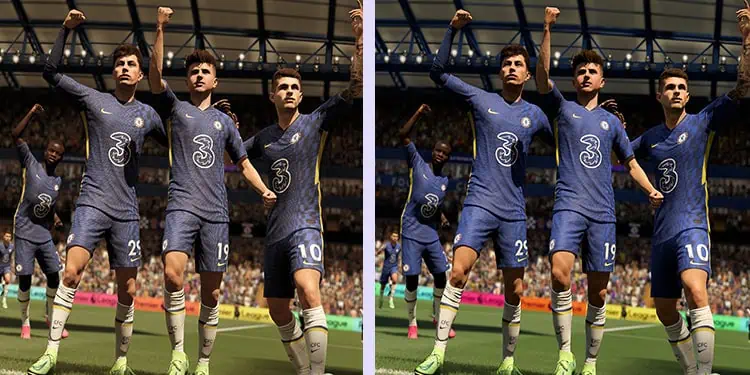
Display technologies employ certain color gamuts for color reproduction. A display that is able to cover a wider range of color gamut is better able to reproduce the colors accurately.
Traditionally, displays have used sRGB gamut for color reproduction. However, newer displays adopt wider color gamuts such as Adobe RGB, DCI-P3, and Rec.2020.
Typically, VA panels cover 85-90% DCI-P3, less than 85% Adobe RGB, and 60% Rec.2020 color coverage. In contrast, IPS panels are able to cover 97% DCI, 99% Adobe RGB, and 80% Rec.2020.
Thus, in color reproduction, IPS panels come out ahead.
Brightness

Fun fact: screen brightness is measured in candles worth of luminance. That’s right. A display emits light worth several candles of light per square meter, and that is how we measure how bright a screen is. This unit is commonly called “nits” in display technology.
If you have a display with a higher nit number, the more visible it will be in daylight. Screens with lower nits will make you squint for visibility in bright light conditions, which is not ideal.
Exciting as the definition of brightness was, when it comes to comparing IPS vs VA displays, the result currently is basically tied. A display with consistent brightness of 300 nits is preferred for daylight viewing, and in this respect, both these displays obtain passable scores.
Of course, the peak brightness value for a given display might vary depending upon the manufacturer, but that is certainly not something that is limited by technology.
The verdict, thus in this case, is a tie.
Viewing Angle

A panel with good viewing angles can retain good visual performance even when viewed from the sides. If you look at the panel from the side and it starts to look as if you are viewing a negative of a film, or the color looks weird, then the display has a weak viewing angle.
Both IPS and VA panels are capable of around 178 degrees of viewing angle. Hence, it might look like they are tied in this aspect.
However, the vast majority of IPS panels are flat screens while VA panels are curved. A curvature of the screen naturally provides a reduced viewing angle when compared to a flat screen.
Depending upon your use case, you might want one over the other.
Refresh Rate
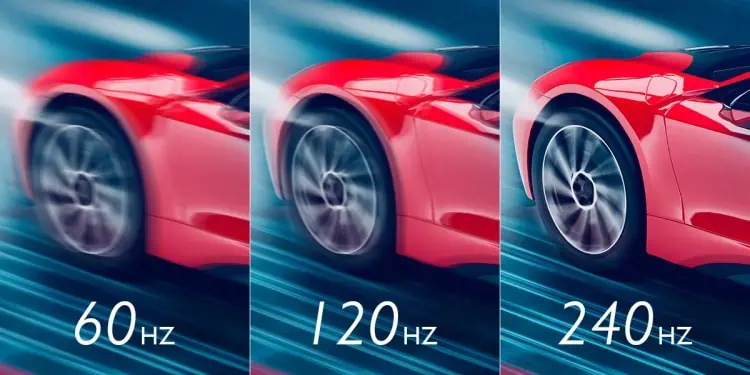
When you are watching a movie, it looks like you are watching a fluid motion. However, in reality, you are watching a series of pictures in quick succession. How many times pictures are drawn into the screen per second is known as its refresh rate.
A higher refresh rate screen appears more fluid in comparison to one with a lower refresh rate. Typically, when you consume a media where you are only passively involved, such as watching a movie or a documentary, you will not need a high refresh rate display.
However, when you are actively involved in the activity that is being presented on the screen, for example, when you are playing a video game, then a slight difference in refresh rate can be noticeable. This is especially true in fast-paced first-person shooters like CS:GO.
The best IPS displays of today are capable of 360 Hz refresh rate in 1080p resolution. The best VA panels, on the other hand, are capable of 240 Hz in 1440 resolution.
Hence, if you are after a display that is capable of the highest refresh rate available in the market today, you need an IPS panel.
Average Response Time

This is the measure of time taken by a pixel to change. A slow changing pixel leaves behind ghosting, and artifacting, even if the display overall has a high refresh rate. Thus, you want the lowest possible average response time in your display.
The most commonly utilized metric to measure a screen’s response time is gray-to-gray (g2g) average. This is measured in milliseconds (ms).
Although both high-end IPS and high-end VA panels today claim a 1ms gtg response time, typical panels are found to have a gtg response time in the vicinity of 4 ms. This is true of both IPS and VA panels.
Motion Performance

In contrast to Cathode Ray Tube (CRT) displays that draw images by scanning pixels, LCD displays hold a pixel during the entirety of refresh time. When you track a moving object on the screen, your eyes are continuously moving. This can create a perceived motion blur.
To solve or mitigate this issue, display manufacturers implement backlight strobing or black frame insertion.
Inserting of intermediate black frames between normal frames is found to reduce the effect of motion blur (black frame insertion).
Another method to combat motion blur is to use a very short strobe to illuminate the display per refresh, achieving a result similar to phosphorus illumination and decay cycle in a CRT display (backlight strobing). The shorter the strobing period, the better the motion quality.
Generally, you can get a good result in both types of panels depending upon the implementation of this technology.
Backlight Bleeds and IPS/VA Glow

Some of the backlights used in LCD may leak out around the bezels because they are not entirely blocked in those areas. This is known as backlight bleeding.
Again, the technology itself has no bearing on backlight bleeds. Some backlight bleed is expected in all LCD monitors, this is a limitation of the technology.
However, a similar phenomenon can occur at the corner of panels, called the IPS or VA glow. This glow can be obvious if you are viewing a content in a dark room with high brightness. This is commonly attributed to defects in the manufacturing process panels.
When the two are compared, IPS glow is generally acceptable as a more serious offender than the VA glow
The Verdict: IPS or VA Panel
From the detailed comparison that we performed of IPS vs VA panels above, we can see that IPS panels are typically well-balanced in most aspects and can perform well as an all-rounder
IPS panels perform well in Adobe RGB and Rec.2020 color spaces, and hence are suitable for color-critical workloads such as video and photo editing. However, their lower performance in contrast ratio can be undesirable when dealing with contrast-heavy work.
IPS panels are also suitable for gamers who play ultra fast-paced FPS games and consistently hit a frame rate of 300+ frames per second.
VA panels have decent coverage of sRGB and DCI-P3 color gamuts, and with such, VA panels are better suitable for video playback and playing video games. Curved screens in a VA display can also help with the experience of immersion. VA panels are also able to achieve a 2-3 times higher contrast ratio, making them suitable for viewing HDR contents.
VA panels are better suitable for gamers and folks who sit close to their desk immersed in their daily workloads.
Differences Between IPS and VA Panels
So here are the few critical differences between an IPS and a VA panel:
| IPS Panel | VA Panel | |
| Color Reproduction | Better color reproduction. (97% DCI, 99% Adobe RGB, and 80% Rec.2020) | Worse color reproduction. (85-90% DCI-P3, less than 85% Adobe RGB, and 60% Rec.2020) |
| Contrast Ratio | Worse contrast ratio. (On average, 1000:1) | Better contrast ratio. (On average, 2000:1 – 3000:1) |
| Refresh Rate | Better refresh rate. (up to 1080p @ 360 Hz) | Worse refresh rate. (up to 1440p @ 240 Hz) |
| Viewing Angle | Better viewing angles. (up to 178 degrees) | Curved VA panels have reduced viewing angle. |
| Backlight Bleed | Undesirable “IPS bleed.” | “VA bleed” is not as bad as “IPS bleed.” |

